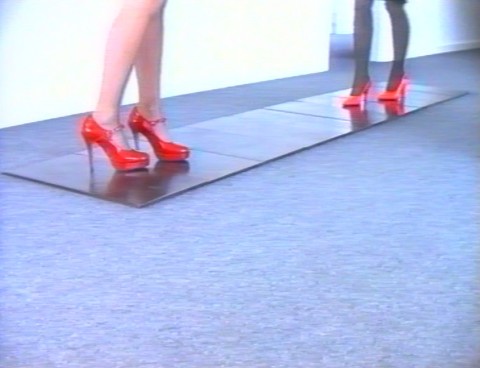Aptly termed “glamorous provocation” by _Index Magazine_, Sylvie Fleury’s work also figures as postmodern, post-feminist Pop art. Her work takes on the masculinism of modern art history and highlights the seductive superficiality of fashion and advertising. However, it evades any overt sociopolitical commentary. Thus, rather than moralizing, her artwork exudes wit and whimsy and, according to Graham Coulter-Smith, suggests “how much better it would be if art galleries could…treat works of art like any other commodity.”
For her first exhibition in 1990, Fleury reconstituted “masterworks” into “feminized” objects—“Mondrians” rendered in synthetic fur and “Fontanas” made from ripped jeans. She also produced Bruce Nauman-esque neon italicized phrases, such as “Life can get heavy mascara shouldn’t” (1999). Recent versions include _Sophisticated Boom Boom!_ (2012), which depicts the expansion of a Damien Hirst “spot painting” into the shape of female breasts.
Similar to the adoration of “high” art, Fleury also has called attention to the fetishization of consumer products. She is known for her installations of luxury brand items such as Chanel shopping bags and Gucci heels, which are often strewn across the floor, as well as crushed American classic cars. Bespeaking the allure of these goods, the one hundred bottles of Egoïste perfume she exhibited at the 1991 Cologne Art Fair had been stolen by visitors by the end of the first day. The following year, Fleury presented branded shopping bags on the floor of the gallery. These objects are not simply readymades, however. She views them as abstract, as the contents of the bags are hidden from view; thus, their seduction is completely superficial. A lack of content or emptiness also serves as a trope in _CHANCE_ (2003), a gilded empty shopping basket, and _ELA 75/K, Easy, Breezy, Beautiful_ (2000), an empty gold-plated shopping cart.
In the mid-1990s, Fleury continued using gloss and sheen in works that collapse the masculine-feminine binary. She incorporated cars and cosmetics into her oeuvre, first exhibiting a 1967 Buick Skylark in a metallic, gold-silver color called Champagne. Accompanying the vehicle was a Chanel compact that had apparently been crushed by the driver. Fleury then began to crush cars for such pieces as _Skincrime2 (Givenchy 601)_ (1997), a crumpled automobile spray-painted with a glossy pink Givenchy nail polish. These works have evolved into “crash test paintings,” slick surfaces that Fleury dents, scratches, and literally crashes into abstractions with a car.
Smashing items also created _Here Comes Santa and Bells_ (2003), both of which feature a woman’s high-heeled feet violently crushing glass Christmas ornaments. Holiday music accompanies the scenes, clashing with the piercing sound of mirrored balls being broken. High heels, a potent signifier of femaleness, also are a recurrent motif in Fleury’s work. In fact, her installation of shoes at Stadtmuseum Esslingen in 1997 proved decisive when she scattered Mondrian-patterned high heels atop one of Carl Andre’s copper “rug” sculptures.
In many ways, Andre’s radical gesture from the 1960s—inviting viewers to walk on, rather than around, his art—perfectly complements the deconstructionist tendencies of Fleury’s art. Nonetheless, she recounts, “Unfortunately it was a short-lived piece, because Mr. Andre didn’t like it. He had it removed after two days… [and] afterwards all the catalogs had my page removed!” Andre’s lack of humor and opposition to Fleury’s decidedly gendered intervention affirms that supposedly progressive art of the 1960s ultimately was a patriarchal discourse.
_Walking on Carl Andre_ (1998) thus functions as a cool yet playful form of retribution on multiple levels. In response to Andre’s censure of Fleury’s installation, the video was made with the aid of collectors in Geneva, who allowed Fleury to record women walking on their own Andre sculptures. According to Fleury, “One could argue that seduction is a reverse power game where the seducer aims at controlling the realm that will over-power him in return.” Perhaps _Walking_ also represents this reversal. Although the interaction of spectators is what Andre desired, Fleury’s video raises the question of what sort of person is anticipated. The sight of stylish, colorful, “feminine” footwear ostensibly thwarts viewers’ expectations and visually overpowers Andre’s art.
Finally, another critical dimension to the work concerns the death of Andre’s wife, Ana Mendieta, who fell from the window of the couple’s thirty-fourth-floor Greenwich Village apartment. Andre was tried and acquitted of murder charges, but, for many viewers, women walking on Andre’s body (of work) figures as a subtle act of vengeance. Like previous and later works by Fleury, _Walking_ reinterprets en-gendered items, proving that their meanings, like fashion and art objects, hardly are authentic and potentially are changeable. _—Kanitra Fletcher_

